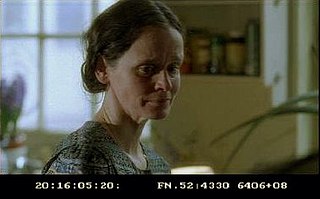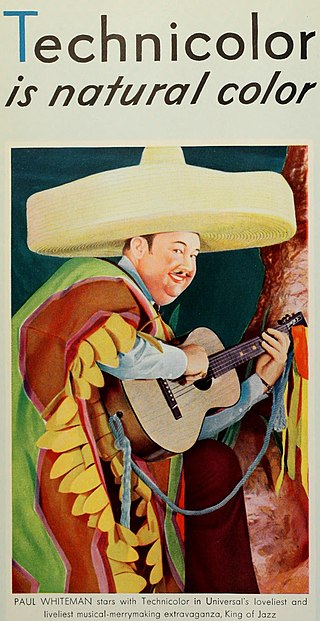
Film stock is an analog medium that is used for recording motion pictures or animation. It is recorded on by a movie camera, developed, edited, and projected onto a screen using a movie projector. It is a strip or sheet of transparent plastic film base coated on one side with a gelatin emulsion containing microscopically small light-sensitive silver halide crystals. The sizes and other characteristics of the crystals determine the sensitivity, contrast and resolution of the film. The emulsion will gradually darken if left exposed to light, but the process is too slow and incomplete to be of any practical use. Instead, a very short exposure to the image formed by a camera lens is used to produce only a very slight chemical change, proportional to the amount of light absorbed by each crystal. This creates an invisible latent image in the emulsion, which can be chemically developed into a visible photograph. In addition to visible light, all films are sensitive to X-rays and high-energy particles. Most are at least slightly sensitive to invisible ultraviolet (UV) light. Some special-purpose films are sensitive into the infrared (IR) region of the spectrum.
Photography is the art, application, and practice of creating durable images by recording light, either electronically by means of an image sensor, or chemically by means of a light-sensitive material such as photographic film. It is employed in many fields of science, manufacturing, and business, as well as its more direct uses for art, film and video production, recreational purposes, hobby, and mass communication.

A photograph is an image created by light falling on a photosensitive surface, usually photographic film or an electronic image sensor, such as a CCD or a CMOS chip. Most photographs are now created using a smartphone/camera, which uses a lens to focus the scene's visible wavelengths of light into a reproduction of what the human eye would see. The process and practice of creating such images is called photography.

The CMYK color model is a subtractive color model, based on the CMY color model, used in color printing, and is also used to describe the printing process itself. The abbreviation CMYK refers to the four ink plates used: cyan, magenta, yellow, and key (black).

Kodachrome is the brand name for a color reversal film introduced by Eastman Kodak in 1935. It was one of the first successful color materials and was used for both cinematography and still photography. For many years Kodachrome was widely used for professional color photography, especially for images intended for publication in print media.

Color grading is a post-production process common to filmmaking and video editing of altering the appearance of an image for presentation in different environments on different devices. Various attributes of an image such as contrast, color, saturation, detail, black level, and white balance may be enhanced whether for motion pictures, videos, or still images. Color grading and color correction are often used synonymously as terms for this process and can include the generation of artistic color effects through creative blending and compositing of different layer masks of the source image. Color grading is generally now performed in a digital process either in a controlled environment such as a color suite, and is usually done in a dim or dark environment.

An image scanner—often abbreviated to just scanner—is a device that optically scans images, printed text, handwriting or an object and converts it to a digital image. Commonly used in offices are variations of the desktop flatbed scanner where the document is placed on a glass window for scanning. Hand-held scanners, where the device is moved by hand, have evolved from text scanning "wands" to 3D scanners used for industrial design, reverse engineering, test and measurement, orthotics, gaming and other applications. Mechanically driven scanners that move the document are typically used for large-format documents, where a flatbed design would be impractical.

A darkroom is used to process photographic film, to make prints and to carry out other associated tasks. It is a room that can be made completely dark to allow the processing of the light-sensitive photographic materials, including film and photographic paper. Various equipment is used in the darkroom, including an enlarger, baths containing chemicals, and running water.

Color photography is photography that uses media capable of capturing and reproducing colors. By contrast, black-and-white or gray-monochrome photography records only a single channel of luminance (brightness) and uses media capable only of showing shades of gray.
The science of photography is the use of chemistry and physics in all aspects of photography. This applies to the camera, its lenses, physical operation of the camera, electronic camera internals, and the process of developing film in order to take and develop pictures properly.

A workprint is a rough version of a motion picture, used by the film editor(s) during the editing process. Such copies generally contain original recorded sound that will later be re-dubbed, stock footage as placeholders for missing shots or special effects, and animation tests for in-production animated shots or sequences.
In filmmaking, dailies are the raw, unedited footage shot during the making of a motion picture. The term comes from when movies were all shot on film because usually at the end of each day, the footage was developed, synced to sound, and printed on film in a batch for viewing the next day by the director, selected actors, and film crew members. After the advent of digital filmmaking, "dailies" were available instantly after the take and the review process was no longer tied to the overnight processing of film and became more asynchronous. Now some reviewing may be done at the shoot, even on location, and raw footage may be immediately sent electronically to anyone in the world who needs to review the takes. For example, a director can review takes from a second unit while the crew is still on location or producers can get timely updates while travelling. Dailies serve as an indication of how the filming and the actors' performances are progressing. The term was also used to describe film dailies as "the first positive prints made by the laboratory from the negative photographed on the previous day".

Mystery of the Wax Museum is a 1933 American pre-Code mystery-horror film directed by Michael Curtiz and starring Lionel Atwill, Fay Wray, Glenda Farrell, and Frank McHugh. It was produced and released by Warner Bros. and filmed in two-color Technicolor; Doctor X and Mystery of the Wax Museum were the last two dramatic fiction films made using this process.
Color prints have been developed since their beginnings in 1935 with Eastman Kodak’s Company’s Kodachrome film, as well in 1936 with Agfa Company’s Agfacolor film. Color print film is the most common type of photographic film in consumer use. Print film produces a negative image when it is developed, requiring it to be reversed again when it is printed onto photographic paper.
The conservation and restoration of photographs is the study of the physical care and treatment of photographic materials. It covers both efforts undertaken by photograph conservators, librarians, archivists, and museum curators who manage photograph collections at a variety of cultural heritage institutions, as well as steps taken to preserve collections of personal and family photographs. It is an umbrella term that includes both preventative preservation activities such as environmental control and conservation techniques that involve treating individual items. Both preservation and conservation require an in-depth understanding of how photographs are made, and the causes and prevention of deterioration. Conservator-restorers use this knowledge to treat photographic materials, stabilizing them from further deterioration, and sometimes restoring them for aesthetic purposes.

Color motion picture film refers both to unexposed color photographic film in a format suitable for use in a motion picture camera, and to finished motion picture film, ready for use in a projector, which bears images in color.
A release print is a copy of a film that is provided to a movie theater for exhibition.
Dye transfer is a continuous-tone color photographic printing process. It was used to print Technicolor films, as well as to produce paper colour prints used in advertising, or large transparencies for display.

Photographic film is a strip or sheet of transparent film base coated on one side with a gelatin emulsion containing microscopically small light-sensitive silver halide crystals. The sizes and other characteristics of the crystals determine the sensitivity, contrast, and resolution of the film.

Technicolor is a series of color motion picture processes, the first version dating back to 1916, and followed by improved versions over several decades.












